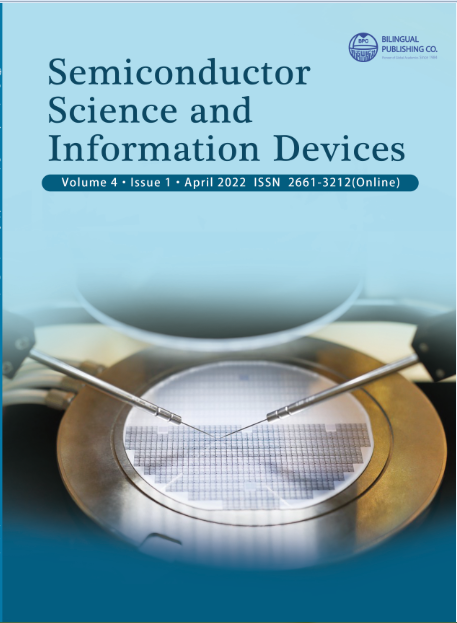Total Energy and Electronic States of CdSe Nanoparticles
DOI:
https://doi.org/10.30564/ssid.v4i1.4420Abstract
The authors fulfilled calculations of the total energy and electronic states of CdnSen nanoparticle:“wurzite”, “sphalerite” and “rock-salt” types of the structure. It was shown that at n ≤ 72 the “rock-salt” type is the most favorable energetically. However the extrapolation of the behavior of the energy per Cd-Se atomic pair shows that for n > 130 (corresponding to a size of about 2 nm), particles with a “wurtzite” structure can be more advantageous. Particles of the “wurtzite” and “rock-salt” types have an electronic structure with an energy gap. For particles with the “wurtzite”structure, the gap width decreases with increasing particle size: from 3.3 eV to 2.2 eV as the particle increases from 0.5 nm to 1.5 nm. For particles of the “rock-salt” type, the gap width grows slightly, remaining about 3 eV.“Sphalerite”-type particles have a metal-like electronic structure.
Keywords:
Nanoparticles, Cadmium selenide, Total energy, Energetic gap, Modeling with pseudopotentialsReferences
[1] Rani, S., Thanka Rajan, S., Shanthi, J., et al., 2015. Review on the materials properties and photoelctrochemical (PEC) solar cells of CdSe, Cd1-xZnxSe, Cd1-xInxSe,thin films. Materials Science Forum. 832, 1-27.DOI: https://doi.org/10.4028/www.scientific.net/MSF.832.1
[2] Talapin, D.V., Nelson, J.H., Shevchenko, E.V., et al.,2007. Seeded Growth of Highly Luminescent CdSe/CdS Nanoheterostructures with Rod and Tetrapod Morphologies. Nanoletters. 7(10), 2951-2959.
[3] Luo, Y., Wang, L.W., 2010. Electronic Structures of the CdSe/CdS Core-Shell Nanorods. ACS Nano. 4(1), 91-98.
[4] Romanova, K.A., Galyametdinov, Y.G., 2021. Quantum-chemical study of CdSe/CdS core/shell and CdSe/CdS/ZnS core/shell/shell quantum dots with different layers ratio. AIP Conference Proceedings.2380, 060001.DOI: https://doi.org/10.1063/5.0058295.
[5] Rosmani, C.H., Zainurul, A.Z., Rusop, M., et al., 2014.The Optical and Electrical Properties of CdSe Nanoparticles. Advanced Materials Research. 832, 557-561.
[6] Abbassi, A., Zarhri, Z., Azahaf, C., et al., 2015.Benyoussef. Boltzmann equations and ab initio calculations: comparative study of cubic and wurtzite CdSe. SpringerPlus. 4, 543.DOI: https://doi.org/10.1186/s40064-015-1321-z.
[7] Wang, X.B., Yu, J.H., Chen, R., 2018. Optical Characteristics of ZnS Passivated CdSe/CdS Quantum Dots for High Photostability and Lasing. Nature. Scientific Reports. 8, 17323.DOI: https://doi.org/10.1038/s41598-018-35768-8.
[8] Wei, S.H., Zhang, S.B., Zunger, A., 2000. First-principles calculation of band offsets, optical bowings,and defects in CdS, CdSe, CdTe, and their alloys.Journal of Applied Physics. 87, N 3
[9] Zhou, W.L., Cai, T., Chen, Y., et al., 2014. Synthesis of CdS-Capped CdSe Nanocrystals without any Poisonous Materials. Advanced Materials Research.981, 806-809.
[10] Hu, J.T., Wang, L.W., Li, L.Sh., et al., 2002. Semiempirical Pseudopotential Calculation of Electronic States of CdSe Quantum Rods. Journal of Physical Chemistry B. 106, 2447-2452.
[11] Jones, M., Lo, Sh.S., Scholes, G.D., 2009. Quantitative modeling of the role of surface traps in CdSe/CdS/ZnS nanocrystal photoluminescence decay dynamics. PNAS. 106(9), 3011-3016.DOI: https://doi.org/10.1073/pnas.0809316106.
[12] Xu, J.M., Ji, X.J., Kerim, M., et al., 2006. Langmuir and Langmuir-Blodgett films of quantum dots. Colloids and Surfaces A: Physicochem. Eng. Aspects.284-285, 35-42.
[13] Ratnesh, R.K., Mehata, M.S., 2017. Synthesis and optical properties of core-multi-shell CdSe/CdS/ZnS quantum dots: Surface modifications. Optical Materials. 64, 250-256.
[14] Proshchenko, V., Dahnovsky, Y., 2014. Spectroscopic and electronic structure properties of CdSe nanocrystals: spheres and cubes. Physical Chemistry Chemical Physics. 16, 7555-7561.
[15] Neeleshwar, S., Chen, C.L., Tsai, C.B., et al., 2005.Size-dependent properties of CdSe quantum dots.Physical Review B: Condens. Matter Mater. Phys.71, 201307(1-4).
[16] Kawano, H., 2021. Effective Work Functions of the Elements, Progress in Surface Science.100583.DOI: https://doi.org/10.1016/j.progsurf.2020.100583.
[17] Beckstedte, M., Kley, A., Neugebauer, J., et al., 1997.Density functional theory calculations for poly-atomic systems: electronic structure, static and elastic properties and ab initio molecular dynamic. Computer Physics Communications. 107, 187-205.
[18] Kohn, W., Sham, J.L., 1965. Self-consistent equations including exchange and correlation effects.Physical Review. 140, A1133-A1138.
[19] Fuchs, M., Scheffler, M., 1999. Ab initio pseudopotentials for electronic structure calculations of poly-atomic systems using density functional theory.Computer Physics Communications. 119, 67-165.
[20] Perdew, J.P., Wang, Y., 1986. Accurate and simple density functional for the electronic exchange energy.Physical Review B. 33, 8800-8802.
[21] Ceperly, D.M., Alder, B.J., 1980. Ground state of the electron gas by a stochastic method. Physical Review Letters. 45, 566-569.
[22] Perdew, J.P., Burke, K., Wang, Y., 1996. Generalized gradient approximation for the exchange-correlation hole of a many electron system. Physical Review B.54, 16533-16539.
[23] Hamman, D.R., 1989. Generalized norm-conserving pseudopotentials. Physical Review B. 40,8503-8513.
[24] Troullier, N., Martins, J.I., 1991. Efficient pseudopotentials for plane-wave calculations. Physical Review B. 43, 1993-2006.




 Aims and Scope
Aims and Scope Victor Zavodinsky
Victor Zavodinsky





